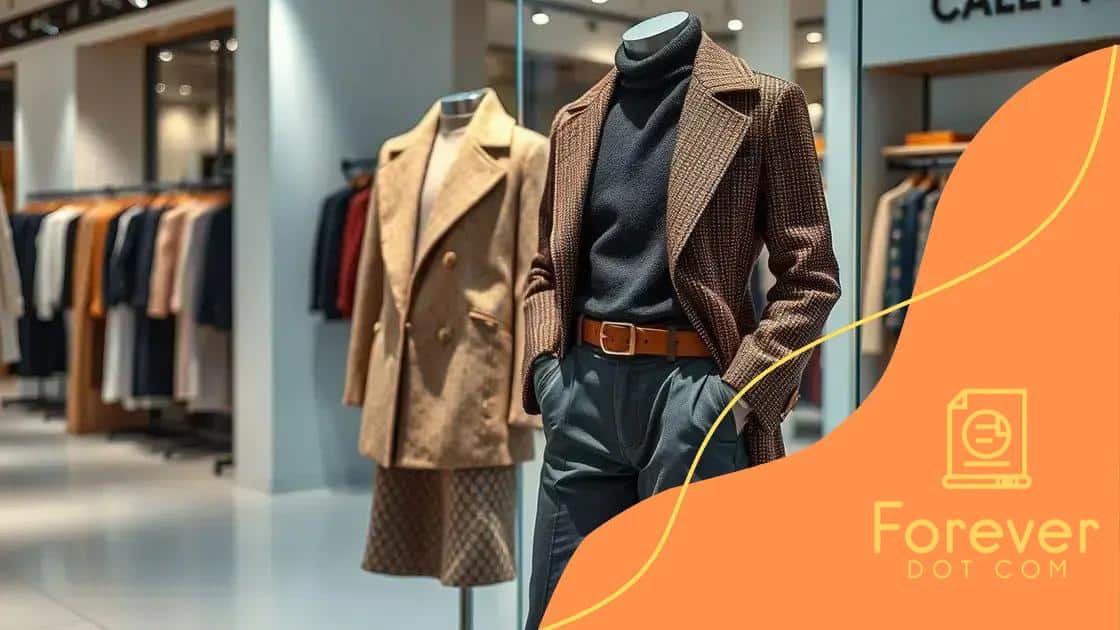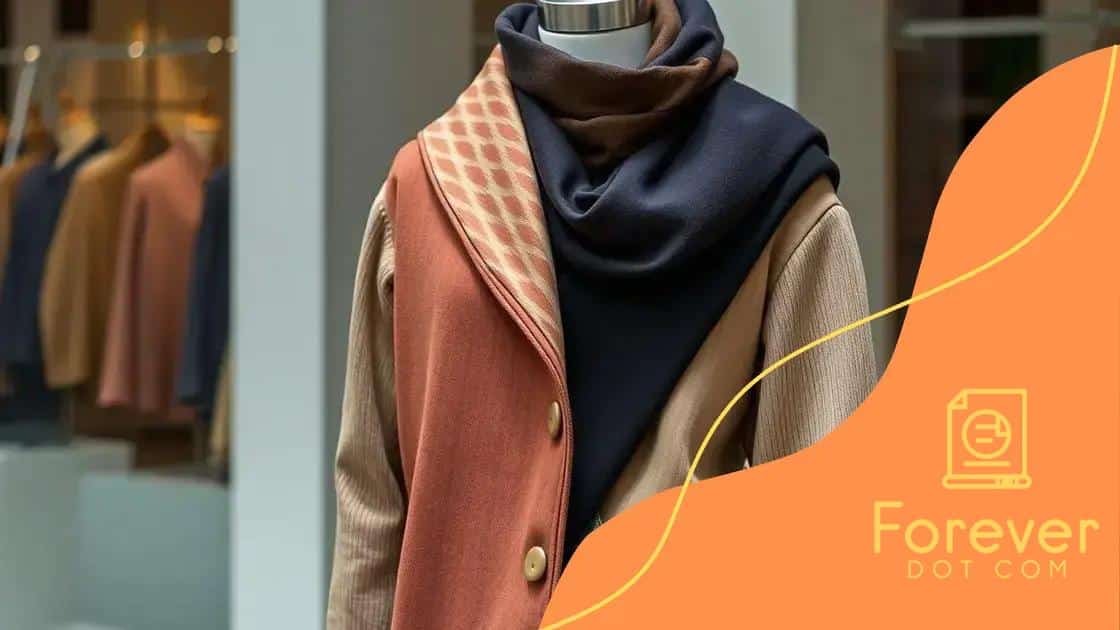Styling tips for mixing textures and fabrics

Styling tips for mixing textures and fabrics include balancing proportions, using accessories wisely, experimenting with colors, and layering different materials to create visually appealing and dynamic outfits.
Styling tips for mixing textures and fabrics can elevate your wardrobe. You might wonder how to combine materials like cotton, silk, and denim for maximum impact. Let’s dive into some simple yet effective strategies!
Understanding the basics of texture
Understanding the basics of texture is essential for creating stylish outfits. Textures bring depth and interest to your clothing choices, making them stand out. By knowing how to mix different textures, you can enhance your overall look effortlessly.
Types of Textures
There are various textures you can experiment with, each offering a unique vibe. Some common examples include:
- Silk: Smooth and luxurious, great for formal events.
- Denim: Casual and versatile, perfect for everyday wear.
- Wool: Warm and cozy, ideal for cooler climates.
- Cotton: Breathable and comfortable, great for layering.
Mixing these textures can create contrast and interest. For instance, pairing a soft silk blouse with a rugged denim jacket can elevate your outfit, making it chic yet casual. Understanding how these materials feel and drape can also inform your choices.
How Texture Affects Style
The texture you select influences the aesthetic of your outfit. A structured fabric like tweed can give a more polished look, while flowing fabrics like chiffon lend themselves to a softer appearance. When planning your outfit, think about how the textures interact with each other.
Remember, balancing textures can heighten your ensemble’s appeal. Too many rough textures can feel overwhelming, while overly soft fabrics may seem too casual. Aim for a harmonious blend that reflects your personal style.
Additionally, color plays an important role in how textures will look together. Neutral colors can make mixing textures easier, allowing the different fabrics to shine without competing for attention. Conversely, bold colors can energize a look but require careful consideration of the textures involved.
Investing time in understanding the basics of texture will significantly enhance your styling skills. By incorporating various textures into your wardrobe, you can create dynamic outfits that showcase your individuality.
Color coordination techniques
Color coordination techniques are crucial for elevating your style and making a lasting impression. Choosing the right colors can create harmony and balance in your outfits. Understanding how colors work together enhances your ability to mix textures and fabrics effectively.
Understanding Color Theory
At the heart of color coordination is color theory. This theory explains how colors relate to each other on the color wheel. Complementary colors, which are opposite each other, provide a vibrant look. Analogous colors, found next to each other, create a serene and comfortable style.
- Complementary colors: Red and green, blue and orange.
- Analogous colors: Blue, teal, and green.
- Triadic colors: Using three colors evenly spaced on the color wheel.
- Monochromatic colors: Different shades and tints of the same color.
When you grasp these fundamentals, you can easily mix and match different pieces in your wardrobe.
Using Neutrals as a Base
Neutrals such as black, white, beige, and gray are versatile. They can anchor your outfit, allowing brighter colors to stand out. Pair a vibrant top with neutral pants to create balance. This technique helps in coordinating various textures too. A silk blouse with a textured skirt looks chic when combined with neutral shoes.
Don’t shy away from color! Incorporating bold hues can transform an ordinary outfit. A pop of color through an accessory, like a scarf or handbag, can enhance your look. Experiment with different combinations to find what makes you feel confident.
Remember, the aim is to create a cohesive look that reflects your style. Play around with color swatches to visualize how colors work together, and don’t be afraid to mix tones. This approach not only works for fabrics but also for accessories, shoes, and outerwear.
Layering different fabrics

Layering different fabrics is an effective styling technique that adds depth and dimension to your outfits. This approach allows you to combine various textures, creating a visually appealing look while also adapting to changing weather conditions. It’s both functional and fashionable.
Choosing the Right Fabrics
When layering, it’s important to select fabrics that complement each other. Lightweight materials, such as cotton or silk, work well as a base layer. These fabrics provide comfort without adding bulk. For mid-layers, consider options like knit sweaters or denim jackets that offer warmth without compromising style.
- Base layer: Lightweight and breathable fabrics.
- Mid-layer: Textured sweaters or cardigans.
- Outer layer: Structured jackets or coats.
Blending textures can elevate your outfit, making it more interesting. For instance, wearing a fitted cotton shirt under a chunky knit sweater creates a lovely contrast. Additionally, pairing a sleek silk blouse with a wool blazer combines elegance with structure.
Tips for Successful Layering
To master the art of layering, keep a few key tips in mind. First, play with lengths and proportions. A longer tunic layered beneath a cropped jacket can create a stylish silhouette. Balance is crucial; for instance, if your top is voluminous, opt for slimmer bottoms.
Also, consider color coordination. Layering different colors can be striking, especially when you maintain a cohesive palette. Select shades that complement one another to avoid clashing. This strategy is particularly useful when mixing different textures.
Don’t forget about accessories! Scarves, belts, and bags can add finishing touches to your layered look. A belt can define your waist over a loose outfit, while a scarf can introduce an additional layer of texture and color.
Accessorizing with textures
Accessorizing with textures can significantly enhance your overall outfit. The right accessories add depth and interest, making your look more dynamic. By understanding how different textures interact, you can elevate even the simplest of outfits.
Choosing Textured Accessories
When selecting accessories, consider items like scarves, bags, and jewelry. Each accessory can introduce a unique texture to your ensemble. For example, pairing a smooth leather bag with a chunky knit scarf creates a balance that is visually appealing.
- Scarves: Lightweight silk or heavy wool work well for different seasons.
- Bags: A textured bag can serve as a statement piece.
- Jewelry: Mixing materials like metal and fabric adds richness.
Incorporating these elements allows you to play with contrasts. A matte finish bracelet can complement a shiny fabric top, making both pieces stand out. To create a cohesive look, consider using accessories that share similar colors but different textures.
Layering Accessories
Layering accessories can be a fun way to express your style. Consider stacking different bracelets or wearing multiple necklaces of varying lengths. This layering technique adds dimension and draws the eye, creating a focal point in your outfit.
Don’t hesitate to experiment with bold textures, such as pairing a rough leather belt with a smooth dress. This contrast highlights both elements, showcasing your attention to detail. The key is to maintain balance; if you choose bold textures for one accessory, keep the other aspects simple.
Ultimately, accessorizing with textures allows for personal expression. Whether you prefer subtle layers or bold statements, different textures can enhance your style. The goal is to find combinations that reflect your personality and make you feel good.
Common mistakes to avoid in styling
Common mistakes to avoid in styling can help you elevate your fashion game. Many people overlook vital aspects that make their outfits shine. By being aware of these errors, you can enhance your style and make more confident choices.
Ignoring Proportions
One common mistake in styling is ignoring proportions. It’s essential to balance fitted and oversized pieces. Wearing all tight or all loose garments creates an unflattering silhouette. Instead, combine a fitted top with relaxed bottoms for a harmonious look.
- Fit is key: Ensure at least one piece in your outfit fits well.
- Play with lengths: Pair long tops with shorter bottoms or vice versa.
- Mix styles: Don’t hesitate to combine casual and formal pieces.
Understanding how to balance proportions can drastically affect your overall appearance.
Overlooking Accessories
Another frequent mistake is overlooking the power of accessories. Accessories can transform a basic outfit into something special. A simple dress can look more put together with the right belt, handbag, or jewelry.
However, avoid overdoing it. Aim for a few statement pieces rather than cluttering your look with too many items. This helps maintain focus on your overall outfit.
Sticking to One Color Palette
While having a signature color palette can be fantastic, sticking to just one can make your outfits feel flat. Don’t be afraid to incorporate different hues. Mixing colors and textures adds depth to your style, making it more interesting.
Experimenting with new colors can also refresh your wardrobe. Try different combinations to see what works best for you. Understanding color coordination will make your outfits pop.
By avoiding common mistakes like these, you can improve your styling skills. Confidence in your outfit comes from understanding how to mix textures, colors, and shapes effectively. Incorporate these tips, and you’ll find yourself creating stylish, unique looks with ease.
In conclusion, styling is about balancing textures, colors, and accessories to create standout outfits. By avoiding common mistakes and experimenting with different combinations, you can enhance your personal style. Remember to play with proportions and have fun using accessories to elevate your looks. With practice, you’ll develop a wardrobe that reflects your personality and confidence.
FAQ – Styling Tips for Mixing Textures and Fabrics
What are some common mistakes in styling?
Common mistakes include ignoring proportions, underestimating accessories, sticking to one color palette, and not layering textures.
How can I mix textures effectively?
To mix textures, try combining different fabrics like silk and denim or pairing a chunky knit with a smooth blouse for contrast.
What accessories should I use to enhance my outfit?
Use accessories like scarves, statement jewelry, and textured bags to add depth and interest to your style.
How can I find my personal style?
Experiment with different textures, colors, and accessories, and pay attention to what makes you feel confident and comfortable.






